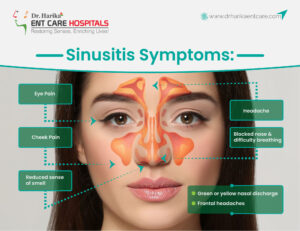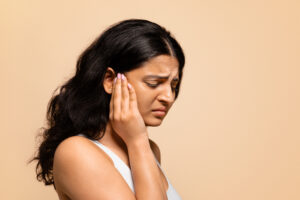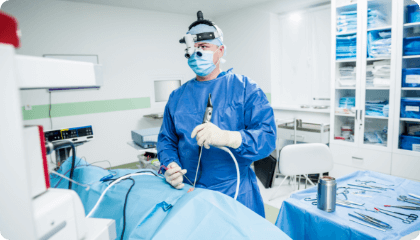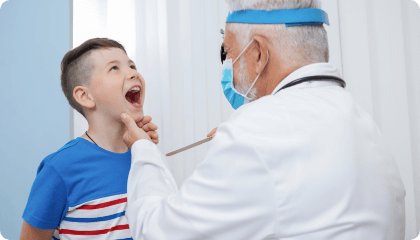A hollow space in the human body is referred to as a sinus. There are different types of sinuses, but sinusitis affects the space behind the face, known as a paranasal sinus. This sinus leads to the nasal cavity. The lining of paranasal sinuses has the same composition as that of the nose and secrete a slimy substance known as mucus. The nasal passages are kept moist because of this mucus and help in capturing germs and other dirt/dust particles. Sinusitis happens when mucus builds up causes the sinuses to become swollen, inflamed, and irritated. The condition is referred to as sinusitis only when it doesn't heal for three months or more, despite being treated.
Common Symptoms of Sinusitis
Some common symptoms that are experienced by individuals suffering from chronic sinusitis include:
- Hard or dried mucus blocks nasal passages
- Problem in tasting or smelling foods and beverages
- Discomfort or tenderness in the face, especially around foreheads, eyes, and cheeks
- Postnasal drip or mucus dripping at the back of the throat
- Green or yellowish coloured mucus dripping from nose
An individual must have at least two of the above symptoms to be diagnosed as chronic sinusitis.
There are some more common symptoms of chronic sinusitis, which include:
- Throat soreness
- Feeling nauseous
- Headaches because of swelling and pressure in the sinuses
- Bad breath
- Pain in ears
- Exhaustion
- Jaw and tooth soreness
- Cough that tends to worsen at night
Cause of Sinusitis
Some common causes of chronic sinusitis include the following:
- Growth of tissue inside the nose, known as polyps. These polyps or enlarged tissue blocks the sinuses and make breathing difficult.
- Infection in windpipe, nose, or lungs by bacteria or viruses. Cold may also be the cause of the infection. These are respiratory tract infections and cause inflammation in the nose. The pathway of the mucus is blocked, and the mucus is trapped inside, unable to drain.
- Allergies to various things such as pollen, chemicals or similar such allergens. Hay fever is one of the major reasons to get sinusitis. It causes severe inflammation in the nasal passages.
- A deviated septum which is the growth of an uneven wall of tissue between your nostrils tends to limit the flow of air in either one or both nostrils. The individual tends to have problems in breathing.
There are some other health conditions also that may cause chronic sinusitis.
These conditions include:
- GERD or Gastroesophageal Reflux Disease which is a disease of the digestive tract
- Asthma which causes severe inflammation in the air tract
- A condition is known as cystic fibrosis which causes mucus build-up which doesn’t drain. This collected mucus causes bacterial infections and problems in breathing.
- HIV or Human Immunodeficiency Virus, a condition which weakens the complete immune system.
Treatment of Acute Sinusitis
Acute and Subacute Sinusitis
Doctor may prescribe antibiotics if there is a bacterial infection. If the symptoms continue to persist even after the individual has completed the course of the antibiotics, then the next level of treatment must be given to the individual.
Chronic Sinusitis
If the sinusitis persists, then it is unlikely that bacteria is the cause, and antibiotics may not be able to provide any relief. In this case, the individual must be suggested to reduce exposure to allergens like pollen, dust mites, etc. Sprays and tablets prescribed by a doctor may help in managing some inflammation. Some nasal corticosteroids include fluticasone, mometasone, triamcinolone etc
Nasal sprays or solutions can be used for saline nasal irrigation. This helps in rinsing away the allergies and irritants. If the individual has nasal polyps, then corticosteroids can be given orally or can be injected. However, oral corticosteroids do have certain side effects and are used only when the individual has severe symptoms of sinusitis.
Endoscopic Surgery
If nothing seems to work, then the doctor may suggest surgery. The doctor will perform an endoscopic sinus surgery for individuals who don't get any relief after all types of treatments. An endoscope which is a thin and flexible pipe is used to perform the surgery. The tube has a light attached to its head. The doctor uses this to explore the sinus passages, and depending on the source of obstruction, the doctor may use different instruments to shave the polyp or the tissue that is blocking the nasal passage. Clearing the nasal passage helps in drainage and provides relief to the individual.
Septoplasty or Rhinoplasty
Septoplasty is the surgery for deviated septum (as mentioned above causes for sinusitis). The tissue or the wall of the nose is reshaped so the individual can easily breathe through both the nostrils.
Sinusitis should not be ignored as there can be many serious complications, including permanent loss of ability to smell. The infection will spread, causing inflammation in the brain and spinal cord or loss of vision, or infection of bones and skin. Speak to your doctor and treat your condition.
Recent Posts
-
The Importance of Hearing Tests: When and Why You Should Get One
Hearing loss can affect anyone, but early detection is key! Learn the signs, when to get tested, and how ENT specialists can help. Schedule your hearing test today at Dr. Harika ENT Hospital!
02 Apr, 2025
-
Effective Tips for Managing Seasonal Allergies and Sinus Issues
Struggling with seasonal allergies? Learn how to manage nasal congestion, sneezing, and sinus discomfort with expert tips. Discover common triggers, effective relief methods, and when to seek help from an ENT specialist. Find relief at Dr. Harika ENT Hospital—schedule a consultation today!
02 Apr, 2025
-
Understanding Common Ear Infections: Causes, Symptoms, and Treatment Options
Suffering from ear pain, infections, or hearing issues? Learn about common ear infections, their causes, symptoms, and treatment options. Get expert ENT care at Dr. Harika ENT Hospital.
01 Aug, 2024
-
Understanding Cobblestone Throat: Causes, Symptoms, and Treatment
Understanding Cobblestone Throat
25 Jul, 2024
-
Common ENT Problems During the Monsoon Season and When to Seek Medical Intervention
Common ENT Problems During the Monsoon
25 Jul, 2024
-
Chronic Sinusitis Symptoms and its Treatment
Inflammation in the paranasal sinuses is termed as sinusitis. There are some uncomfortable symptoms that people suffering from it may experience. Here is what you should know about sinusitis.
17 May, 2021
-
Snoring In Children And Its Advanced Treatment Options
Snoring is a noise that occurs during sleep when the child is breathing and there is a blockage in the air passage at the back of the nose. About 1-3% of children not only snore but also suffer from breathing problems during sleep. Children who are 3 yrs or older tend to snore during deeper stages of sleep
26 Feb, 2021












